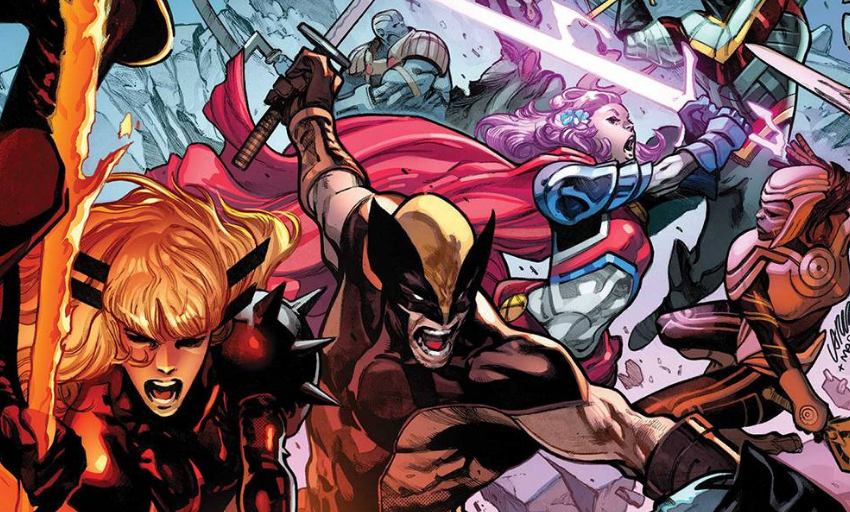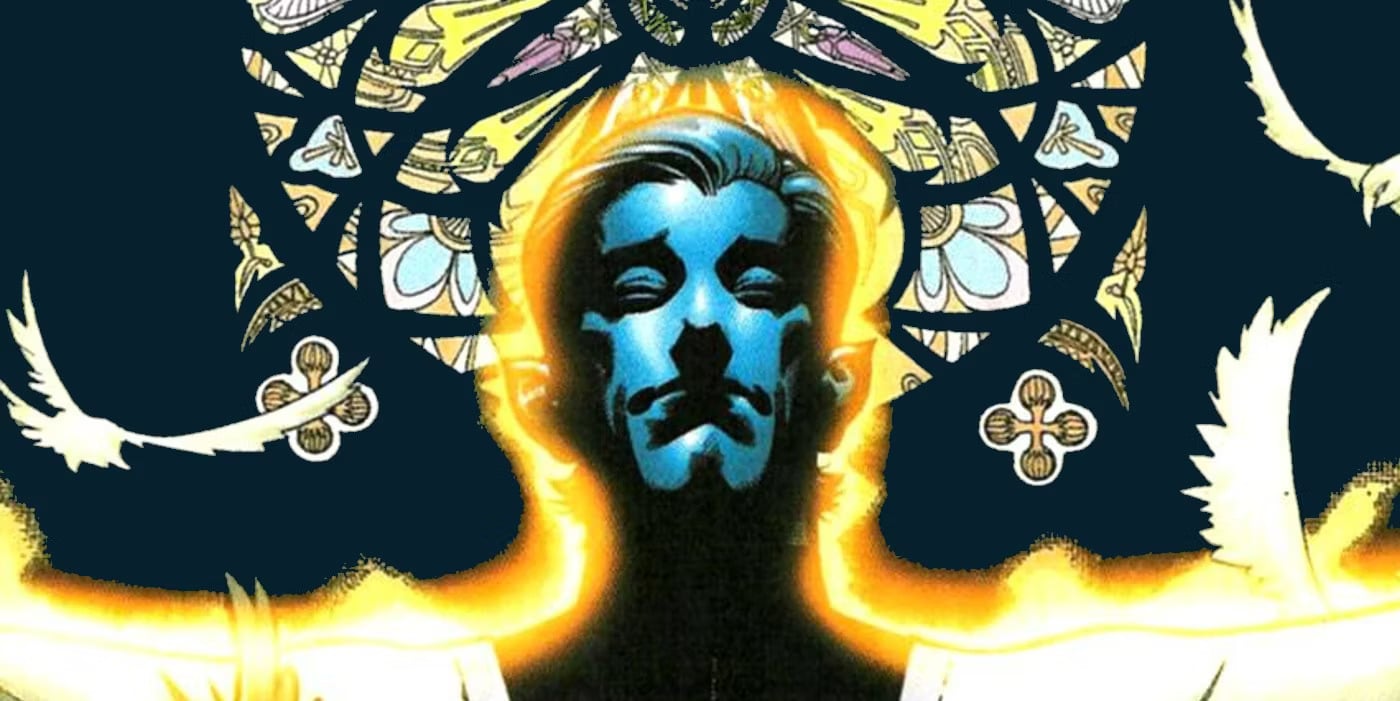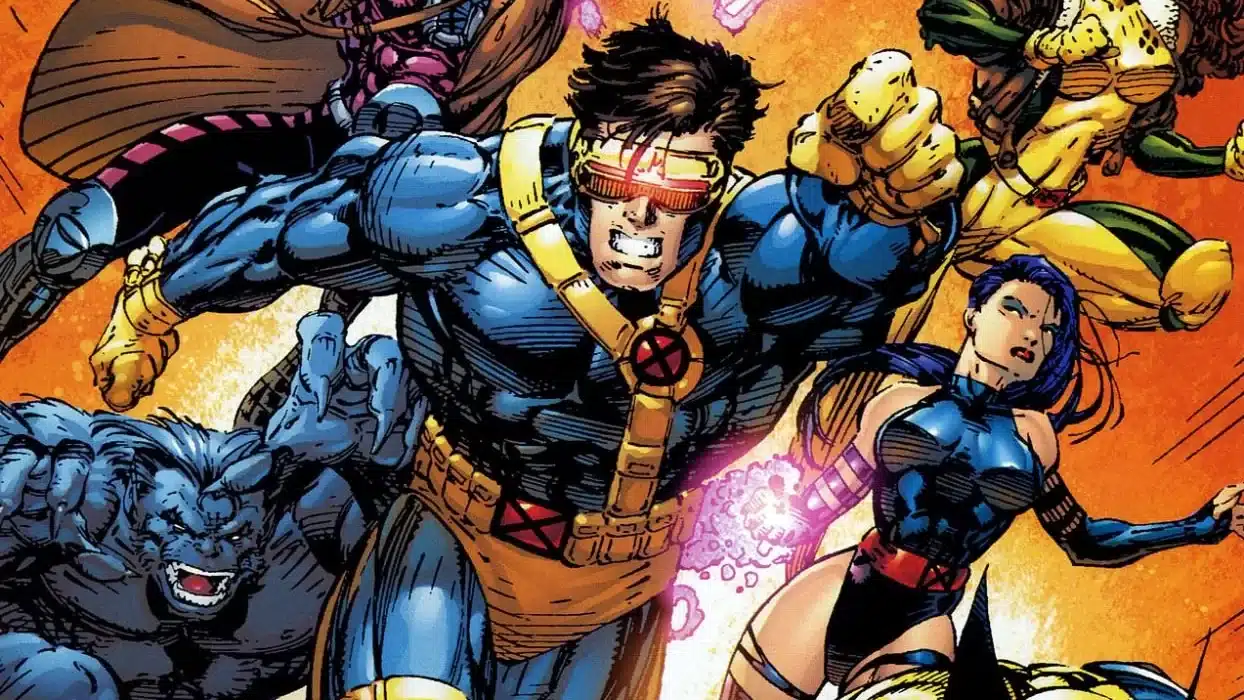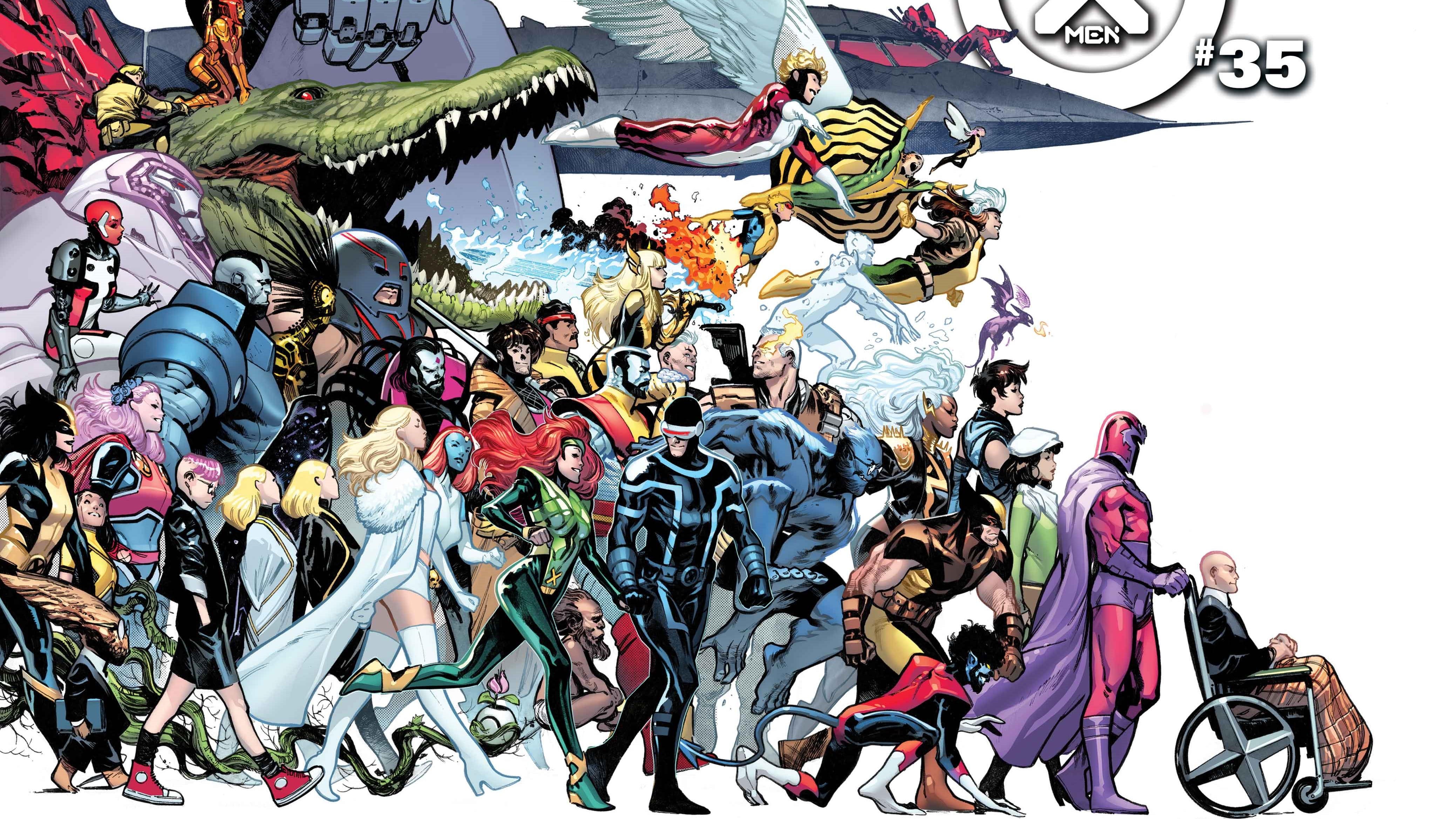We’ve established a definition for tournament arcs and identified their function in a story, as well as some of their standard tropes (and if you don’t know what I’m talking about, read the previous installment in this series). There are a surplus of manga tournament arcs, but they occur significantly less frequently in superhero comics. There’s one in The Immortal Iron Fist, clearly modeled after the same martial arts movies that inspired Dragon Ball. The current Phoenix arc in Jason Aaron’s Avengers has some of the trappings of a tournament arc (a series of successive fights with a prize at the end) but lacks the formal organization and rules we established as core to the genre. In fact, Avengers appears to be following more in the tradition of Marvel’s free-wheeling crossover super-fight series like Secret Wars (1984) and Contest of Champions.
Our findings about manga tournament arcs can be applied to any of these series, with some caveats, but they are most applicable to X of Swords, whose structure and goals are most like manga tournament arcs. By using X of Swords as a test case, we can see where manga and comics storytelling overlap, and apply those lessons to the tournament arcs in Iron Fist or Avengers. First, though, we have one crucial question to answer: Is X of Swords actually a tournament arc?
Tournament Qualifications
Tournament arcs are distinguished by the presence of an organizer, rules and a reward. X of Swords: Creation establishes most of these stakes, though the details of each are slightly messy. Saturnyne is the organizer of the competition, but also technically one of its contestants, in that the Arrakans seek to march their army through Saturnyne’s land to conquer Krakoa, and Saturnyne stands between them and that goal. Though the X-Men are made to compete in the tournament, they are doing so on behalf of Saturnyne, as their overall goals align in that respect. So while Saturnyne is the organizer of the tournament, she does so according to her own interests and will, making her an active participant in the tournament.
The rules of the tournament are also intentionally vague. Each side must present 10 competitors, each with a sword. Saturnyne chooses the method of competition for each contestant, awarding points based on whom she determines to be the victor of each contest. However, the contests themselves are illogical and their rules are according to the whim of Saturnyne. While some rules definitely persist (Saturnyne does conclude that attempting to murder each other before the contest is against the rules, but as both the X-Men and the Arrakans attempted murder, their violations cancel out), the individual rules of the contest are flexible. Despite the confusion this creates during the contests themselves, Saturnyne’s running tally means the competitors (and readers) can easily follow who is winning and losing during the event itself.
One more point stands in the way of easy classification of X of Swords as a tournament arc: The tournament itself doesn’t actually begin until the 15th issue (out of 22). Instead, much time is spent on establishing the tournament, gathering the swords and competitors, and staking out the opposing team. This definitely breaks the mold of manga tournament arcs, which introduce and begin the tournament usually within a few chapters. There was a good deal of criticism leveled at X of Swords for this unusual pacing decision, and the way many of the actual tournament matches were sped through in a single page or panel.
| Arc | No. of Chapters Between Tournament Announcement and First Match |
| 21st World Tournament | 3 |
| Dark Tournament | 2 |
| Chunin Exams | 2 |
| Kumagawa Incident | 3 |
| Sports Festival | 2 |
| X of Swords | 15 |
Given that the preparatory chapters all happen after the announcement of the tournament, and are directly related to the tournament itself, this long wind-up time does not mean that X of Swords isn’t a tournament arc. However, it does reflect a different priority in the pacing. Rather than introduce characters through flashbacks, as is common in manga, X of Swords keeps things fairly linear, explaining characters’ backstories and powers before the tournament actually begins, or during the events proper. This reflects a difference in narrative style between Western comics and Japanese manga, much like how the use of thought bubbles has fallen out of favor in the former but is still common in the latter. Manga tend to denote flashbacks by changing the gutter color from white to black, making it easy to tell when something has happened in the past. Western comics lack this shorthand, making flashbacks unwieldy and confusing. I believe the reason for X of Swords’ long intro period is that it lacks the interruptions common in manga tournament arcs, which pause mid-fight to reveal events that occurred prior to the tournament. It is easy to imagine a version of X of Swords in this style: Wolverine steps up to fight with the Muramasa blade before a two-issue flashback reveals how he obtained it. X of Swords simply makes the choice to order this content as it occurred chronologically.
Tournament Tropes

Last time, I determined the following about manga tournament arcs: They are used as narrative markers, acting as an easy way to end storylines as well as introduce new characters and plots. Tournament arcs typically don’t surprise the readers by keeping to their set form and heavily foreshadowing the final adversary. Tournaments are an opportunity for the heroes to shine as heroes by making friends with the enemies and resisting opponents’ attempts to cheat. X of Swords does not exactly follow the model set by manga tournament arcs, and those points of deviation are especially worth analysis.
There’s no doubt that X of Swords acts as a narrative marker: X of Swords ends the “Dawn of X” period that began with House of X/Powers of X and sets up the subsequent “Reign of X” period. Several long-running plot points are resolved, such as the presence of Summoner on Krakoa and Apocalypse’s plans in Excalibur, but even more characters are introduced. The arrival of Arrako on Earth brings about many new mutants and a serious status quo shift for the X-line, and because of the tournament arc, all of the key players (both allies and villains) have already been introduced.
Some elements of Saturnyne’s tournament are particularly obvious, in the style of straightforward manga tournament arcs. The final adversary of X of Swords, Annihilation, is heavily foreshadowed, as with other tournament arcs. The contest also does come to an official end, with the X-Men declared winners, though it falls apart slightly before Saturnyne declares a winner. In these respects, X of Swords plays out like a standard tournament arc.
However, X of Swords does go out of its way to mislead the reader to preserve some surprises. The reader is led to believe it will be a standard fighting tournament, and fans speculated on potential matchups in the weeks leading up to the start of the tournament. However, the actual challenges were rarely direct combat, and multiple challenges were completed in a single issue. The assumption that X of Swords was going to feature a series of one-on-one swordfights was based on the tropes of tournament arcs. Though tournament arcs feature more and more non-combat rounds from the 2000s on, X of Swords heavily de-emphasized traditional combat. Furthermore, Saturnyne’s judging was confusing, illogical or seemingly biased, as if based on the fae reasoning of the Otherworld. Many tournament arcs feature a judge or organizer out to get the protagonist, but Saturnyne’s methods were particularly disorienting and extreme, which served to draw attention to the ways she was using the tournament to further her own goals.
X of Swords also plays with the traditional morality of shounen manga. Sure, the Arrakans try to cheat by poisoning Doug, but Wolverine similarly attempts to cheat by murdering Saturnyne. X-Men comics are not expected to uphold the same moral pillars as Weekly Shonen Jump action manga, and the mutual cheating reinforces the stakes of the tournament, as well as the desperation of its competitors (besides, on the Krakoa side, half the team has at one point been characterized as a supervillain). Though Saturnyne herself is actively playing against the X-Men, including attempting to brainwash Brian to prevent the tournament from having its full players, she does uphold the bargain of the tournament and ultimately declare the X-Men the rightful winners. The most traditional morality element in X of Swords is the presence of enemies to friends — or, perhaps, enemies to brides, as Doug marries Bei the Blood Moon during a challenge, and she appears to be a part of the recurring cast going forward.
What Makes the Tournament Rare?

We’ve just established the ways that X of Swords benefits from the traditional tournament arc format and manipulates it to surprise readers. For an action superhero comic franchise like X-Men, a tournament arc appears to be a natural fit: a way to show off characters’ powers, establish unusual matchups and introduce a wide array of new characters who can be focus-tested through the arc. Yet tournament arcs are uncommon in superhero comics. The first difficulty in introducing tournament arcs is economic, and the second is demographic. No matter how useful or exciting a tournament arc can be, if it does not fit into the publishing schedule and audience of a comic, then it’s just a waste of time and money.
Consider the different publishing circumstances around Weekly Shonen Jump and X-Men comics. Weekly Shonen Jump is weekly, runs 20 (give or take a few) series simultaneously, and can be purchased at any convenience store for just ¥250 (or roughly $2.50). A single X-Men comic runs $3.99 or more, and must be purchased either by mail order or at a local comic shop. When a reader buys WSJ, they aren’t just buying a single installment in their favorite series, but access to all of the series in WSJ. That means that if a particular arc isn’t very interesting, or is running too long, there are still 19 other potential series to enjoy with the same purchase. In Western superhero comics, a reader is paying more money for a single issue, and if they are dissatisfied with the series, they will stop buying it; a dissatisfied WSJ reader is unlikely to cease purchasing the magazine over a single series.
Of course, this price disparity is mostly tied up in production values: Single-issue comics are meant to be collected and stored, whereas the large magazine version of WSJ is disposable, and collectors typically buy collected volumes of their favorite manga. Mangaka in Japan are also severely overworked and underpaid in order to reach their weekly deadline, and the production of weekly manga involves significantly less staff than the production of full-color Western comics. A 22-issue tournament arc like the Sports Festival from My Hero Academia costs significantly less, and represents less potential loss of revenue to the magazine, than a 22-issue tournament arc like X of Swords.
Another side effect of how weekly series are distributed in Japan means that arcs can run for much longer. Some tournament arcs ran for just 20 chapters and others for 80. Superhero comics typically stick to six-issue arcs that can be easily collected into a single graphic novel, or 12-issue arcs usually reserved for “prestige” series. The “Dawn of X” books have avoided sticking to predictable arc lengths by intertwining the story of books and jumping between multiple plot threads, but X of Swords was particularly presented as a single story arc, unifying all the books. Its 22-issue length drew a not-insignificant amount of outrage from readers who felt the price of 22 issues was far too great for a single story.
Finally, tournament arcs in Weekly Shonen Jump are aimed specifically at boys under the age of 14. This demographic focus is a luxury compared to X-Men comics, which are expected to appeal to longtime readers of the franchise, experienced comic readers who don’t read X-Men, as well as new fans who don’t typically read comics. The material that appeals to a young comic reader may not appeal to an old fan, or a middle-aged newcomer, to say nothing of the question of gender. This means having to adjust the formula of the tournament arc to appeal to a wider demographic than just young boys (which means introducing more moral complexity, and interactions other than fights). Weekly Shonen Jump manga often appear formulaic because they are protected by the demographic and economic realities of their magazine, allowing them to progressively build and innovate on one another all the while assuming their readership will be with them for the whole ride. By contrast, superhero comics are much more precarious, ever at the risk of cancellation.
What’s the Point?

X of Swords is a tournament arc that both follows and does not follow the common tropes of the genre. This wishy-washy conclusion may not be very satisfying, but it does help in revealing areas where manga and comics are similar and different. The narrative form of the tournament arc is at least partially universal — its value as a narrative marker and method of character introduction is undiminished, regardless of the audience or medium. But X of Swords also reveals areas where our understanding of tournament arcs is overly shaped by shonen manga. The most stark difference is the lack of in-combat flashbacks, a narrative tool heavily utilized by manga that is made impractical by the formal constraints of comics. But we also assume, without being told, that a tournament arc is simply a series of successive fights, fought between two moral authorities (one “good” and one “bad”), and that the organizers of these tournaments rarely have their own agendas that extend outside the tournament itself. X of Swords is a work that relies on our understanding of another medium to trick the reader, to expose them to the same confusion and fantasy that Saturnyne inflicts on the X-Men. Outside of its narrative, looking at X of Swords as a tournament arc reveals to us the fundamental differences in these mediums, not just in how the reader interacts with the work, but how they are produced, funded and distributed. It also shows us just how far removed X-Men comics have become from a “young boys” audience; writers cannot assume a certain demographic makeup, or surefire tradition of success, because of the way the comic-buying audience has evolved over the past 60 years. Tournament arcs are a useful point of comparison for two different traditions of visual storytelling, each with different techniques, assumptions and readers.
Ian Gregory is a writer and co-host of giant robots podcast Mech Ado About Nothing.






